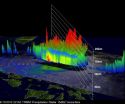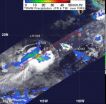(Press-News.org) It's become a sport of sorts, predicting the low point of Arctic sea ice each year. Expert scientists with decades of experience do it but so do enthusiasts, whose guesses are gamely included in a monthly predictions roundup collected by Sea Ice Outlook, an effort supported by the U.S. government.
When averaged, the predictions have come in remarkably close to the mark in the past two years. But the low and high predictions are off by hundreds of thousands of square kilometers.
Researchers are working hard to improve their ability to more accurately predict how much Arctic sea ice will remain at the end of summer. It's an important exercise because knowing why sea ice declines could help scientists better understand climate change and how sea ice is evolving.
This year, researchers from the University of Washington's Polar Science Center are the first to include new NASA sea ice thickness data collected by airplane in a prediction.
They expect 4.4 million square kilometers of remaining ice (about 1.7 million square miles), just barely more than the 4.3 million kilometers in 2007, the lowest year on record for Arctic sea ice. The median of 23 predictions collected by the Sea Ice Outlook and released on Aug. 13 is 4.3 million.
"One drawback to making predictions is historically we've had very little information about the thickness of the ice in the current year," said Ron Lindsay, a climatologist at the Polar Science Center, a department in the UW's Applied Physics Laboratory.
To make their prediction, Lindsay and Jinlun Zhang, an oceanographer in the Polar Science Center, start with a widely used model pioneered by Zhang and known as the Pan-Arctic Ice Ocean Modeling and Assimilation System. That system combines available observations with a model to track sea ice volume, which includes both ice thickness and extent.
But obtaining observations about current-year ice thickness in order to build their short-term prediction is tough. NASA is currently in the process of designing a new satellite that will replace one that used to deliver ice thickness data but has since failed. In the meantime, NASA is running a program called Operation IceBridge that uses airplanes to survey sea ice as well as Arctic ice sheets.
"This is the first year they made a concerted effort to get the data from the aircraft, process it and get it into hands of scientists in a timely manner," Lindsay said. "In the past, we've gotten data from submarines, moorings or satellites but none of that data was available in a timely manner. It took months or even years."
There's a shortcoming to the IceBridge data, however: It's only available through March. The radar used to measure snow depth on the surface of the ice, an important element in the observation system, has trouble accurately gauging the depth once it has melted and so the data is only collected through the early spring before the thaw.
The UW scientists have developed a method for informing their prediction that is starting to be used by others. Researchers have struggled with how best to forecast the weather in the Arctic, which affects ice melt and distribution.
"Jinlun came up with the idea of using the last seven summers. Because the climate is changing so fast, only the recent summers are probably relevant," Lindsay said.
The result is seven different possibilities of what might happen. "The average of those is our best guess," Lindsay said.
Despite the progress in making predictions, the researchers say their abilities to foretell the future will always be limited. Because they can't forecast the weather very far in advance and because the ice is strongly affected by winds, they have little confidence beyond what the long-term trend tells us in predictions that are made far in advance.
"The accuracy of our prediction really depends on time," Zhang said. "Our June 1 prediction for the Sept. 15 low point has high uncertainty but as we approach the end of June or July, the uncertainty goes down and the accuracy goes up."
In hindsight, that's true historically for the average predictions collected by Study of Environmental Arctic Change's Sea Ice Outlook, a project funded by the National Science Foundation and the National Oceanic and Atmospheric Administration.
While the competitive aspect of the predictions is fun, the researchers aren't in it to win it.
"Essentially it's not for prediction but for understanding," Zhang said. "We do it to improve our understanding of sea ice processes, in terms of how dynamic processes affect the seasonal evolution of sea ice."
That may not be entirely the same for the enthusiasts who contribute a prediction. One climate blog polls readers in the summer for their best estimate of the sea ice low point. It's included among the predictions collected by the Sea Ice Outlook, with an asterisk noting it as a "public outlook."
INFORMATION:
The National Science Foundation and NASA funds the UW research into the Arctic sea ice low point.
For more information, contact Lindsay at lindsay@apl.washington.edu or 206-543-5409
Zhang at zhang@apl.washington.edu or 206-543-5569
Girls with Attention Deficit Hyperactivity Disorder (ADHD) – and their families – often look forward to the likely decline in visible symptoms such as fidgety or disruptive behavior as they mature into young women.
However, new findings from UC Berkeley caution that, as they enter adulthood, girls with histories of ADHD are more prone to internalize their struggles and feelings of failure – a development that can manifest itself in self-injury and even attempted suicide.
"Like boys with ADHD, girls continue to have problems with academic achievement and relationships, ...
An intensifying Tropical storm called Kai-Tak (locally known as Helen) is causing more rain in the Philippines as it passes over northern Luzon. The Philippines have had a very wet month with the capital of Manila experiencing massive flooding earlier this month. NASA's TRMM satellite identified where the heavy rain was falling.
Kai-tak has caused another day of warnings in the Philippines. On August 14, Public storm warning signal #1 is in effect for these provinces in Luzon: La Union, Nueva Ecija, Pangasinan, Rest of Aurora, and Tarlac.
In addition, Public storm warning ...
Tropical Storm Hector is battling wind shear over the open waters of the Eastern Pacific Ocean, and NASA satellite data shows that has been affecting its organization and rainfall rates.
The Tropical Rainfall Measuring Mission satellite known as TRMM is managed by both NASA and the Japanese Space Agency. From its orbit in space, TRMM's instruments can estimate rainfall from tropical cyclones.
The TRMM satellite captured rainfall rates from Tropical Storm Hector on August 14, 2012 1:28 a.m. EDT. TRMM data showed that Hector had a small area of moderate to heavy rainfall ...
VIDEO:
Filmed at 10,000 frames per second by Japan's NHK television, movies like this of electromagnetic bursts called "sprites " will help scientists better understand how weather high in the atmosphere relates...
Click here for more information.
High above the clouds during thunderstorms, some 50 miles above Earth a different kind of lightning dances. Bursts of red and blue light, known as "sprites," flash for a scant one thousandth of a second. They are often ...
Many elderly people spend their last years alone. Spouses pass and children scatter. But being lonely is much more than a silent house and a lack of companionship. Over time, loneliness not only takes a toll on the psyche but can have a serious physical impact as well.
Feeling lonely has been linked to an increased risk of heart disease, Alzheimer's disease, depression and even premature death. Developing effective treatments to reduce loneliness in older adults is essential, but previous treatment efforts have had limited success.
What to do? Researchers at UCLA ...
In 1714, the British government held a contest. They offered a large cash prize to anyone who could solve the vexing "longitude problem" — how to determine a ship's east/west position on the open ocean — since none of their naval experts had been able to do so.
Lots of people gave it a try. One of them, a self-educated carpenter named John Harrison, invented the marine chronometer — a rugged and highly precise clock — that did the trick. For the first time, sailors could accurately determine their location at sea.
A centuries-old problem was solved. And, arguably, crowdsourcing ...
Two researchers at Weill Cornell Medical College have deciphered a mouse's retina's neural code and coupled this information to a novel prosthetic device to restore sight to blind mice. The researchers say they have also cracked the code for a monkey retina — which is essentially identical to that of a human —and hope to quickly design and test a device that blind humans can use.
The breakthrough, reported in the Proceedings of the National Academy of Sciences (PNAS), signals a remarkable advance in longstanding efforts to restore vision. Current prosthetics provide blind ...
Tiny space age probes — those that can see inside single living cells — are increasingly being used to diagnose illness in hard-to-reach areas of the body.
NewYork-Presbyterian Hospital/Weill Cornell Medical Center's Dr. Michel Kahaleh often threads a tiny microscope into the narrow bile ducts that connect the liver to the small intestine to hunt for cancer. He also uses the device to minutely explore the pancreatic duct as one of a few doctors in the country to use such technology in this way.
But because these devices are comparatively new, Dr. Kahaleh, chief of ...
SEATTLE – Yo-yo dieting – the repetitive loss and regain of body weight, also called weight cycling – is prevalent in the Western world, affecting an estimated 10 percent to 40 percent of the population. The degree to which weight cycling may impact metabolism or thwart a person's ability to lose weight in the long run has been unclear – until now.
A new study by researchers at Fred Hutchinson Cancer Research Center, published online in the journal Metabolism, for the first time has shown that a history of yo-yo dieting does not negatively affect metabolism or the ability ...
ROCHESTER, Minn. -- Strawberry-shaped birthmarks called infantile hemangiomas (http://www.mayoclinic.com/health/hemangioma/DS00848) grow rapidly in infants much earlier than previously thought, Mayo Clinic and University of California, San Francisco, researchers found. Their study, published online in the journal Pediatrics (http://pediatrics.aappublications.org/), suggests that babies with complication-causing hemangiomas should be immediately referred to dermatologists for further evaluation.
MULTIMEDIA ALERT: For multimedia resources and video of Dr. Tollefson, ...

